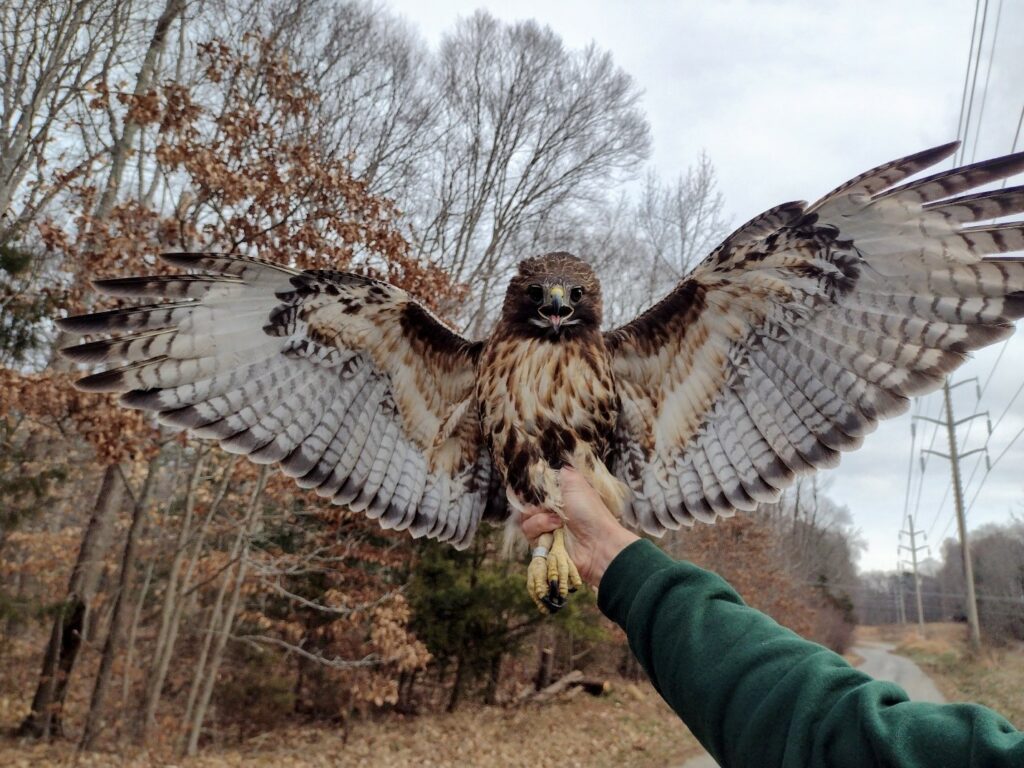Put a Ring on It: Banding Raptors in Calvert

By Molly Weeks Crumbley
This time of year, drivers might notice a Natural Resources van parked along Route 4 in the southern part of Calvert County. They aren’t looking for deer or poachers, but are on the hunt for raptors.
“While I enjoy the variety you can find within all the species of birds, raptors have always fascinated me,” says Gene Groshon, a naturalist with the county’s wildlife division. Groshon has been with the division for 10 years and spends his days out looking for birds of prey to outfit with a tiny metal band around their leg for the Winter Raptor Research Program.
“Watching a hawk or falcon hunt is an amazing experience,” he says. “Raptors have such unique skills and adaptations to help them survive. When you get to see these birds up close you can really notice traits carried over from their dinosaur ancestors.”
It took four years of training to get his federal permit through the USGS Bird Banding Laboratory, based at the Patuxent Wildlife Research Center in Laurel. The USGS laboratory issues permits for banding in the U.S. and distributes the aluminum bands—about 1 million a year—to participating scientists in the U.S. and Canada, and is a central repository for banding records in both countries.

Year-round, Groshon is working with staff and volunteers to conduct local avian research. “I currently run several bird banding research projects that cover a variety of bird species from tiny warblers to large hawks,” he explains.
In winter, however, the focus becomes primarily on birds of prey that are active during the day. From late fall through early spring, Groshon wants to see what species use the area for their wintering grounds. In addition to road surveys counting the number of different raptors in the area, Groshon also sets traps to capture and band American kestrels, red-shouldered hawks, and red-tailed hawks.

“Banding these birds allows us to see if individuals are using the same wintering grounds year after year and if they are staying in the area during the breeding season,” he says.
Groshon’s banding project began in 2014 when he noticed the population of kestrels in the county was higher in the winter than in the breeding season. After an unsuccessful spring installing and monitoring nest boxes for the kestrels, Groshon wanted to find out where the birds were breeding and if they were coming back to the same wintering sites each year. This is particularly important as the species population is currently in decline in the United States.
So how does one safely catch one of these predatory birds? When a raptor is spotted, the team parks their van in a safe location and lays their Bal-chatri trap, a wire cage covered with monofilament nooses sized to ensnare the leg of the target species. A live mouse is then placed inside the trap to lure the bird in.
“The traps have been specifically designed to keep the mouse and bird as safe as possible,” assures Groshon. “With all our projects, the bird’s well-being is our number one priority. The Bird Banding Laboratory requires thorough experience before being approved [to use] these capture techniques. When a raptor lands on the trap to go after the mouse, its legs will get caught in a noose, enabling us to capture it.”
Once a bird is successfully snared, Groshon carefully secures it. It’s no easy feat as Groshon works without protective globes to maintain dexterity.
“We carefully grab the bird by the upper legs and then extract the feet out of the trap’s nooses. You must be very careful as these birds are very eager to shake your hand with a foot full of talons.”
Once the raptor is securely in hand, it can be banded, measured, photographed, and observed. The entire process, from capture to release, only takes a few minutes.
Even though the project is ongoing, data is already answering some of Groshon’s questions. “In our second year of running the project, I recaptured two of the American kestrels I banded the previous year. Both were captured within 500 feet of where I had banded them the previous year. Since they had not been seen in these areas during the spring and summer it is proof that they returned from their breeding grounds to the exact same wintering location. Data like this teaches us that wintering habitat sites are just as important as breeding sites.”
He also recently had his first capture of a bird that had been banded by a researcher in New Jersey, whom he was then able to contact.
Volunteers are needed to cover more territory, says Groshon. Some training is required.
Find details on the Winter Raptor Research program, the Raptor Road Surveys, and Identification Qualification at https://calvertstewards.galaxydigital.com.

